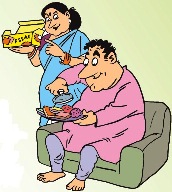August-19 cover story
- Posted by CERC India
- Posted in August
Adulterated sweets: Threat to food safetyÂ
June 7 was designated World Food Safety Day. Grahak Sathi shares some tips to spot adulteration in sweets Â
  The United Nations has designated June 7 as World Food Safety Day. Food safety is the absence – or safe, acceptable levels – of hazards in food that may harm the health of consumers. Food-borne hazards can be microbiological, chemical or physical. An estimated 600 million – almost 1 in 10 people in the world – fall ill after eating contaminated food every year. One of the biggest enemies of food safety is adulteration.
 The United Nations has designated June 7 as World Food Safety Day. Food safety is the absence – or safe, acceptable levels – of hazards in food that may harm the health of consumers. Food-borne hazards can be microbiological, chemical or physical. An estimated 600 million – almost 1 in 10 people in the world – fall ill after eating contaminated food every year. One of the biggest enemies of food safety is adulteration.
Food adulteration is an act of intentionally debasing the quality of food offered for sale most commonly by substitution with cheaper, inferior ingredients.Â
Adulteration in sweetsÂ
Sweets are common food items that are adulterated especially when their demand soars during festivals. This is particularly true of milk-based sweets. Some of the ingredients that can be adulterated are – milk, ghee, sugar, khoya or the silver foil (vark) on them.
Silver foil: Many sweets have silver foil on them. However, sellers are replacing this with aluminium foil which poses health hazards. Consuming it can cause serious stomach infections. Try observing the sweet first. If the foil is cracked all over, it is definitely adulterated as pure vark will spread out effortlessly over the surface of the sweet. Another way of checking is touching the top of the sweetmeat gently with your finger. If the foil comes onto your finger, chances are it is fake.
Artificial sweetener: Taste a small quantity of the sample. An artificial sweetener leaves a lingering sweetness on the tongue and a bitter aftertaste.
Khoya: Starch is commonly added to khoya to give a thick, rich texture to sweets. To check for adulterated khoya, take a small sample and mix it with water and bring to boil. Allow it to cool and add two drops of iodine in the solution. If the solution turns blue, starch is present.
Another way to figure out if khoya is pure is to rub some of it on your palm. If it is greasy and leaves behind a slight saccharine taste, go for it!
Milk: Milk can contain something as harmless as water but could also contain urea or detergent. For the detergent test, dilute the milk sample and shake it vigorously. If you see an unnatural amount of lather formation, the milk has detergent. To check for urea, add few teaspoons of milk in a cup and mix it with a teaspoon of either soya powder or tuar daal (pigeon pea) powder. Next, dip a litmus paper into this mixture. If the colour changes to blue, do not use the milk, as it has urea in it.
Ghee: One of the simplest methods to check ghee is to heat a teaspoon of it in a pan. If the ghee melts instantly and turns dark brownish in colour, then it is pure ghee. If it takes time to melt and turns yellow, then it may be adulterated. To test for starch, take half a teaspoon of ghee in a glass bowl. Add two drops of iodine. If the mixture turns blue it confirms the presence of a starchy substance.
Sugar: Take water in a glass and dissolve 10 gm of the sample in it. If there is a white sediment it is usually chalk powder.Â
Consumer awareness is vital to eliminate the evil of adulteration and sale of substandard food products. Efforts by the government, producers and consumers help ensure food safety.Â
Tips on buying sweetsÂ
- Look for the FSSAI (Food Safety and Standards Authority of India) logos and the licence number on boxes of packaged sweets.
- Check the best before/expiry date.
- Buy sweetmeats from a reputed shop and select well-known brands.
- If you are making sweets at home purchase ingredients from a reliable vendor who has an FSSAI licence. Ensure that shop maintains basic hygiene standards.
- Always taste or smell the sweets before buying in bulk. Stale products emit a musty smell and taste slightly sour.
Sources:Â www.un.org, www.ndtv.com, www.thebetterindia.com



